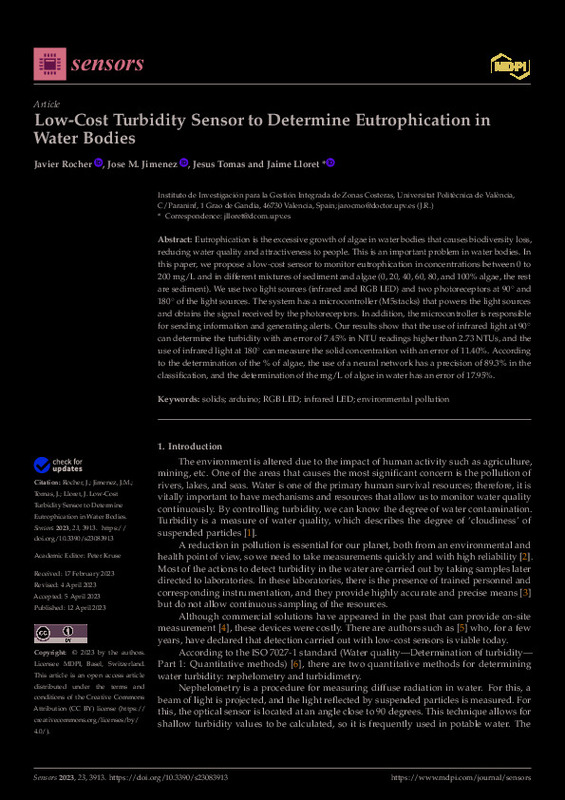JavaScript is disabled for your browser. Some features of this site may not work without it.
Buscar en RiuNet
Listar
Mi cuenta
Estadísticas
Ayuda RiuNet
Admin. UPV
Low-Cost Turbidity Sensor to Determine Eutrophication in Water Bodies
Mostrar el registro sencillo del ítem
Ficheros en el ítem
| dc.contributor.author | Rocher, Javier
|
es_ES |
| dc.contributor.author | Jimenez, Jose M.
|
es_ES |
| dc.contributor.author | Tomás Gironés, Jesús
|
es_ES |
| dc.contributor.author | Lloret, Jaime
|
es_ES |
| dc.date.accessioned | 2024-01-12T19:02:02Z | |
| dc.date.available | 2024-01-12T19:02:02Z | |
| dc.date.issued | 2023-04 | es_ES |
| dc.identifier.uri | http://hdl.handle.net/10251/201893 | |
| dc.description.abstract | [EN] Eutrophication is the excessive growth of algae in water bodies that causes biodiversity loss, reducing water quality and attractiveness to people. This is an important problem in water bodies. In this paper, we propose a low-cost sensor to monitor eutrophication in concentrations between 0 to 200 mg/L and in different mixtures of sediment and algae (0, 20, 40, 60, 80, and 100% algae, the rest are sediment). We use two light sources (infrared and RGB LED) and two photoreceptors at 90 degrees and 180 degrees of the light sources. The system has a microcontroller (M5stacks) that powers the light sources and obtains the signal received by the photoreceptors. In addition, the microcontroller is responsible for sending information and generating alerts. Our results show that the use of infrared light at 90 degrees can determine the turbidity with an error of 7.45% in NTU readings higher than 2.73 NTUs, and the use of infrared light at 180 degrees can measure the solid concentration with an error of 11.40%. According to the determination of the % of algae, the use of a neural network has a precision of 89.3% in the classification, and the determination of the mg/L of algae in water has an error of 17.95%. | es_ES |
| dc.description.sponsorship | This study forms part of the ThinkInAzul program and was supported by MCIN with funding from European Union NextGenerationEU (PRTR-C17.I1) and by Generalitat Valenciana (THINKINAZUL/2021/002). | es_ES |
| dc.language | Inglés | es_ES |
| dc.publisher | MDPI AG | es_ES |
| dc.relation.ispartof | Sensors | es_ES |
| dc.rights | Reconocimiento (by) | es_ES |
| dc.subject | Solids | es_ES |
| dc.subject | Arduino | es_ES |
| dc.subject | RGB LED | es_ES |
| dc.subject | Infrared LED | es_ES |
| dc.subject | Environmental pollution | es_ES |
| dc.subject.classification | INGENIERÍA TELEMÁTICA | es_ES |
| dc.title | Low-Cost Turbidity Sensor to Determine Eutrophication in Water Bodies | es_ES |
| dc.type | Artículo | es_ES |
| dc.identifier.doi | 10.3390/s23083913 | es_ES |
| dc.relation.projectID | info:eu-repo/grantAgreement/GV INNOV.UNI.CIENCIA//THINKINAZUL%2F2021%2F002//Red de Sensores y big data para la observacion del entorno marino (SALVADOR)/ | es_ES |
| dc.relation.projectID | info:eu-repo/grantAgreement/MICINN//PRTR-C17.I1/ | es_ES |
| dc.rights.accessRights | Abierto | es_ES |
| dc.contributor.affiliation | Universitat Politècnica de València. Departamento de Tecnología de Alimentos - Departament de Tecnologia d'Aliments | es_ES |
| dc.contributor.affiliation | Universitat Politècnica de València. Escuela Politécnica Superior de Gandia - Escola Politècnica Superior de Gandia | es_ES |
| dc.description.bibliographicCitation | Rocher, J.; Jimenez, JM.; Tomás Gironés, J.; Lloret, J. (2023). Low-Cost Turbidity Sensor to Determine Eutrophication in Water Bodies. Sensors. 23(8):1-26. https://doi.org/10.3390/s23083913 | es_ES |
| dc.description.accrualMethod | S | es_ES |
| dc.relation.publisherversion | https://doi.org/10.3390/s23083913 | es_ES |
| dc.description.upvformatpinicio | 1 | es_ES |
| dc.description.upvformatpfin | 26 | es_ES |
| dc.type.version | info:eu-repo/semantics/publishedVersion | es_ES |
| dc.description.volume | 23 | es_ES |
| dc.description.issue | 8 | es_ES |
| dc.identifier.eissn | 1424-8220 | es_ES |
| dc.identifier.pmid | 37112254 | es_ES |
| dc.identifier.pmcid | PMC10143286 | es_ES |
| dc.relation.pasarela | S\496523 | es_ES |
| dc.contributor.funder | European Commission | es_ES |
| dc.contributor.funder | GENERALITAT VALENCIANA | es_ES |
| dc.contributor.funder | Ministerio de Ciencia e Innovación | es_ES |








